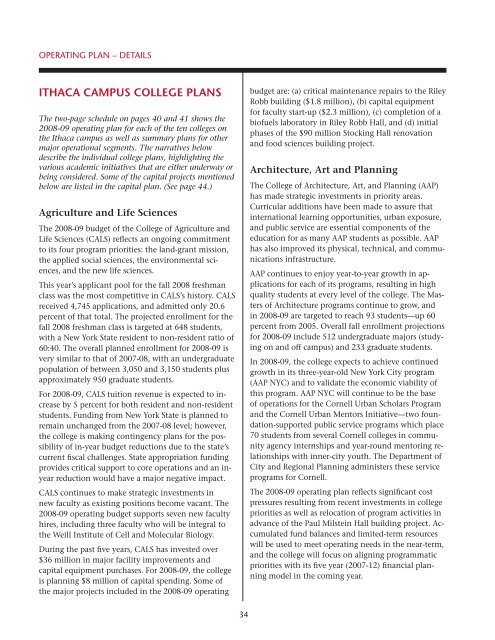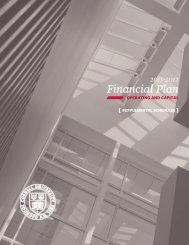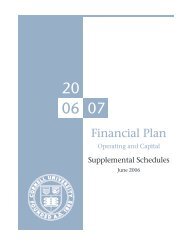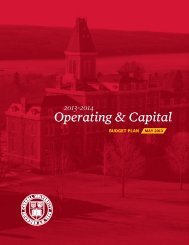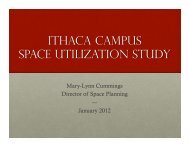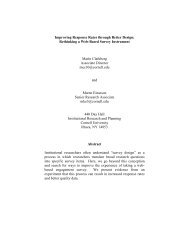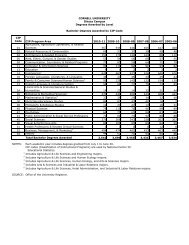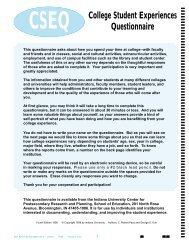Operating plan – DetailsIthaca Campus College <strong>Plan</strong>sThe two-page schedule on pages 40 and 41 shows the2008-09 operating plan for each <strong>of</strong> the ten colleges onthe Ithaca campus as well as summary plans for othermajor operational segments. The narratives belowdescribe the individual college plans, highlighting thevarious academic initiatives that are either underway orbeing considered. Some <strong>of</strong> the capital projects mentionedbelow are listed in the capital plan. (See page 44.)Agriculture and Life SciencesThe 2008-09 budget <strong>of</strong> the College <strong>of</strong> Agriculture andLife Sciences (CALS) reflects an ongoing commitmentto its four program priorities: the land-grant mission,the applied social sciences, the environmental sciences,and the new life sciences.This year’s applicant pool for the fall 2008 freshmanclass was the most competitive in CALS’s history. CALSreceived 4,745 applications, and admitted only 20.6percent <strong>of</strong> that total. The projected enrollment for thefall 2008 freshman class is targeted at 648 students,with a New York State resident to non-resident ratio <strong>of</strong>60:40. The overall planned enrollment for 2008-09 isvery similar to that <strong>of</strong> 2007-08, with an undergraduatepopulation <strong>of</strong> between 3,050 and 3,150 students plusapproximately 950 graduate students.For 2008-09, CALS tuition revenue is expected to increaseby 5 percent for both resident and non-residentstudents. Funding from New York State is planned toremain unchanged from the 2007-08 level; however,the college is making contingency plans for the possibility<strong>of</strong> in-year budget reductions due to the state’scurrent fiscal challenges. State appropriation fundingprovides critical support to core operations and an inyearreduction would have a major negative impact.CALS continues to make strategic investments innew faculty as existing positions become vacant. The2008-09 operating budget supports seven new facultyhires, including three faculty who will be integral tothe Weill Institute <strong>of</strong> Cell and Molecular Biology.During the past five years, CALS has invested over$36 million in major facility improvements andcapital equipment purchases. For 2008-09, the collegeis planning $8 million <strong>of</strong> capital spending. Some <strong>of</strong>the major projects included in the 2008-09 operatingbudget are: (a) critical maintenance repairs to the RileyRobb building ($1.8 million), (b) capital equipmentfor faculty start-up ($2.3 million), (c) completion <strong>of</strong> abi<strong>of</strong>uels laboratory in Riley Robb Hall, and (d) initialphases <strong>of</strong> the $90 million Stocking Hall renovationand food sciences building project.Architecture, Art and <strong>Plan</strong>ningThe College <strong>of</strong> Architecture, Art, and <strong>Plan</strong>ning (AAP)has made strategic investments in priority areas.Curricular additions have been made to assure thatinternational learning opportunities, urban exposure,and public service are essential components <strong>of</strong> theeducation for as many AAP students as possible. AAPhas also improved its physical, technical, and communicationsinfrastructure.AAP continues to enjoy year-to-year growth in applicationsfor each <strong>of</strong> its programs, resulting in highquality students at every level <strong>of</strong> the college. The Masters<strong>of</strong> Architecture programs continue to grow, andin 2008-09 are targeted to reach 93 students—up 60percent from 2005. Overall fall enrollment projectionsfor 2008-09 include 512 undergraduate majors (studyingon and <strong>of</strong>f campus) and 233 graduate students.In 2008-09, the college expects to achieve continuedgrowth in its three-year-old New York City program(AAP NYC) and to validate the economic viability <strong>of</strong>this program. AAP NYC will continue to be the base<strong>of</strong> operations for the <strong>Cornell</strong> Urban Scholars Programand the <strong>Cornell</strong> Urban Mentors Initiative—two foundation-supportedpublic service programs which place70 students from several <strong>Cornell</strong> colleges in communityagency internships and year-round mentoring relationshipswith inner-city youth. The Department <strong>of</strong>City and Regional <strong>Plan</strong>ning administers these serviceprograms for <strong>Cornell</strong>.The 2008-09 operating plan reflects significant costpressures resulting from recent investments in collegepriorities as well as relocation <strong>of</strong> program activities inadvance <strong>of</strong> the Paul Milstein Hall building project. Accumulatedfund balances and limited-term resourceswill be used to meet operating needs in the near-term,and the college will focus on aligning programmaticpriorities with its five year (2007-12) financial planningmodel in the coming year.34
Operating plan – DetailsSignificant capital project activity will continue in thecollege in 2008-09, including a renovation project tobuild elevators and accessible washrooms to addressAmericans with Disabilities Act (ADA) complianceneeds for the college and the Fine Arts Library. Thisproject will lead to the removal <strong>of</strong> trailers from thenorth side <strong>of</strong> Sibley Hall and continue the substantialrelocation <strong>of</strong> some students, faculty, and staff thatbegan in 2007. The trailer moves will also prepare theway for the construction <strong>of</strong> Milstein Hall, due to startin late 2008 or early 2009.Arts and SciencesThe College <strong>of</strong> Arts and Sciences, one <strong>of</strong> the strongestliberal arts colleges in the country, has a faculty<strong>of</strong> 529 who teach both undergraduate and graduatestudents in more than 40 subjects. The number <strong>of</strong>undergraduate applications to the college grew for afourth straight year, with an increase <strong>of</strong> 4 percent. Thecollege enrolls 4,000 undergraduates and more than1,700 graduate students in its own departments andrelated graduate fields and provides a sizable portion<strong>of</strong> the instruction for the undergraduates <strong>of</strong> theother colleges at <strong>Cornell</strong>. Typically 37 percent <strong>of</strong> thestudents enrolled in the College <strong>of</strong> Engineering and21-25 percent <strong>of</strong> contract college undergraduates takeArts and Sciences courses each year. Arts and Sciencesis committed to <strong>of</strong>fering a rigorous and wide-rangingeducation to students throughout the university andto advancing the frontiers <strong>of</strong> knowledge in all fieldsthrough basic research and scholarship in the naturaland social sciences and the humanities.Faculty recruitment and retention remain top priorities,as the college needs to maintain academicstrength during a period when faculty are retiring ata rapid rate and new areas <strong>of</strong> study are being developedto respond to the increasing internationalization<strong>of</strong> the curriculum, the growth in multidisciplinaryresearch and scholarship, and the development <strong>of</strong>new technologies. Increased <strong>of</strong>ferings in Chinese andArabic and faculty who work in developing areas <strong>of</strong>information science in such diverse departments asLinguistics, Statistics, and Science and TechnologyStudies, as well as in the humanities, are some <strong>of</strong> themost recent manifestations <strong>of</strong> these developments.The college’s 2008-09 financial plan includes a significantinvestment in faculty salaries, to provide strongfinancial incentives and recognition for productivityand promotion, as well as improved funding for newfaculty startup expenses. The high level <strong>of</strong> activity infaculty recruitment and a good success rate in facultyretention is also generating a demand for additionalinvestment in faculty research and summer support aswell as a need to increase the pace at which the collegecreates new facilities and modernizes existing ones.These pressures are reflected in additional capital expensethat has been incorporated in the financial planto cover renovations <strong>of</strong> <strong>of</strong>fice and research space fornew faculty and the cost <strong>of</strong> the initial design work ona new humanities building that will address the severeshortage <strong>of</strong> <strong>of</strong>fice and teaching space in the humanitiesand many <strong>of</strong> the social science departments. In addition,Arts and Sciences has again increased fundingfor instructional technologies, but this is an area thatthe college is studying and which will require moresignificant investments in the near future.The college’s financial plan calls for the use <strong>of</strong> existingfund balances that are being transferred to plant fundsto support the humanities building. The remainingdraw on fund balances is generally restricted in nature,and is being used in accordance with the intendedpurpose <strong>of</strong> the funds.EngineeringThe College <strong>of</strong> Engineering, a nationally ranked, toptenengineering college, enrolls 3,000 undergraduatesannually along with 810 Ph.D. and 470 Masters <strong>of</strong> Engineering(M.Eng.) students and employs 239 faculty,330 academic and non-academic staff, and approximately100 visiting pr<strong>of</strong>essors and scientists.<strong>Budget</strong>ed faculty salary expenditures reflect continuedgrowth in the number <strong>of</strong> faculty positions in areas <strong>of</strong>strategic importance to the college and the university.Included in the 2008-09 plan is the cost <strong>of</strong> pre-filling12 faculty lines in advance <strong>of</strong> expected faculty retirementsand in anticipation <strong>of</strong> future gifts. The collegeis increasing the number <strong>of</strong> tenure-track facultypositions by 30 over a ten-year period, with 15 <strong>of</strong>these new positions in the Department <strong>of</strong> BiomedicalEngineering (BME), which was established in 2004,and the balance in the college’s six strategic areas <strong>of</strong>research priority: systems biology, nanoscience, advancedmaterials, energy and environment, computationalscience and engineering, and complex systems.35
- Page 5 and 6: Operating plan - highlightsIntroduc
- Page 8: Operating plan - highlightsComposit
- Page 11 and 12: Tuition, Financial Aid & Endowmentm
- Page 13 and 14: Tuition, Financial Aid & Endowmentu
- Page 15 and 16: Tuition, Financial Aid & EndowmentC
- Page 17 and 18: Tuition, Financial Aid & Endowmentf
- Page 19 and 20: Tuition, Financial Aid & EndowmentD
- Page 21 and 22: Tuition, Financial Aid & EndowmentC
- Page 23 and 24: Tuition, Financial Aid & EndowmentS
- Page 25 and 26: Tuition, Financial Aid & Endowmentw
- Page 27: Tuition, Financial Aid & Endowmentt
- Page 31 and 32: Tuition, Financial Aid & Endowmentp
- Page 33: Operating plan - DetailsIthaca Camp
- Page 37 and 38: Operating plan - Detailstive staff
- Page 39 and 40: Operating plan - Detailsand develop
- Page 41 and 42: Operating plan - DetailsCentrallyOt
- Page 43 and 44: Operating plan - DetailsMedical Col
- Page 45 and 46: Capital PlanDistribution of Space -
- Page 47 and 48: Capital Plan• New York State supp
- Page 49 and 50: Capital PlanFUNDING SOURCESFINANCIN
- Page 51 and 52: Capital PlanEXPENDITURE PATTERNEsti
- Page 53 and 54: Capital PlanFUNDING SOURCESFINANCIN
- Page 55 and 56: Capital PlanEXPENDITURE PATTERNEsti
- Page 57 and 58: Capital PlanEXPENDITURE PATTERNEsti
- Page 59 and 60: Capital PlanDebt Service by Operati
- Page 61 and 62: BStudent Fees and Other Tuition Rat
- Page 63 and 64: DUndergraduate Tuition, Fees, Room,
- Page 65 and 66: FAverage Nine-Month Faculty Salarie
- Page 67 and 68: HNew York State AppropriationsSourc
- Page 69 and 70: JInvestment Assets, Returns, and Pa
- Page 71 and 72: LGifts/Contributions - Through Marc
- Page 73 and 74: NWorkforce - Ithaca Campus2007-08 I
- Page 75 and 76: PU.S. Senate ResponseThe Senate Com
- Page 77 and 78: U.S. Senate Response (continued)of
- Page 79 and 80: U.S. Senate Response (continued)inc
- Page 81 and 82: U.S. Senate Response (continued)fro
- Page 83 and 84: U.S. Senate Response (continued)Tab
- Page 85 and 86:
U.S. Senate Response (continued)Tab
- Page 87 and 88:
U.S. Senate Response (continued)Tab


